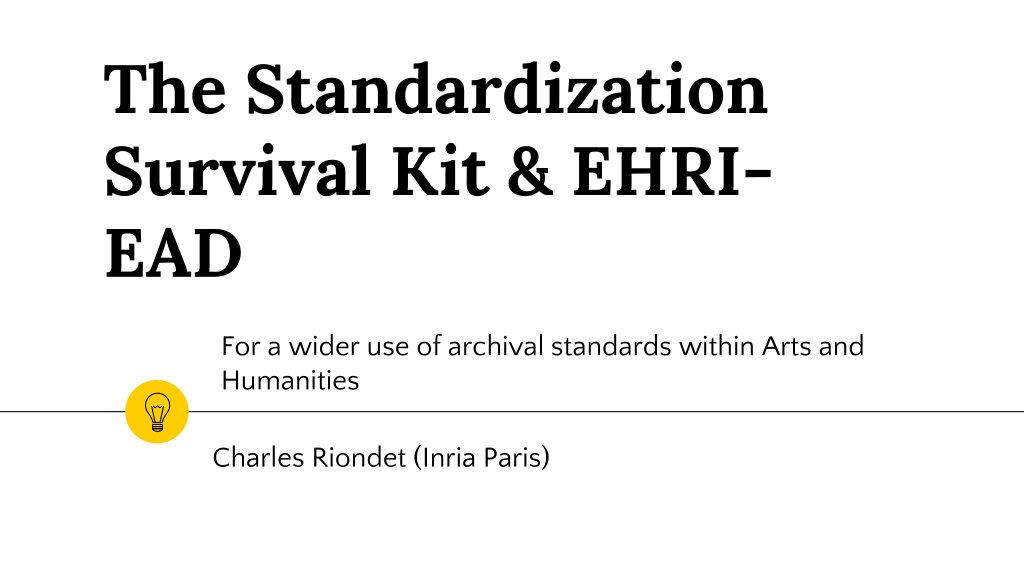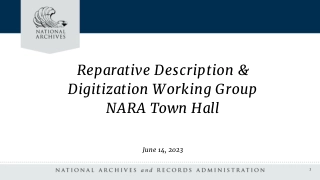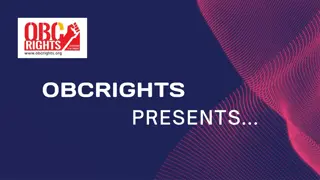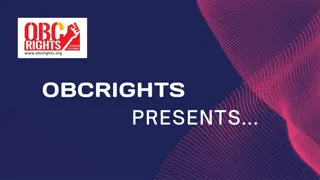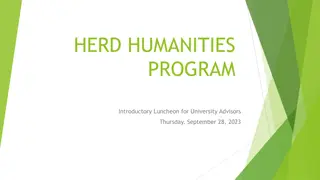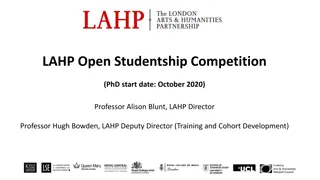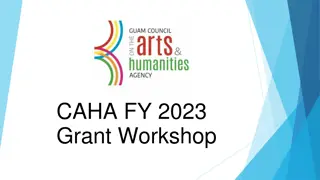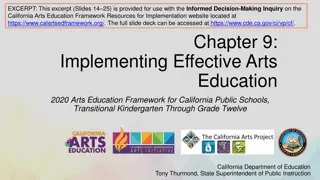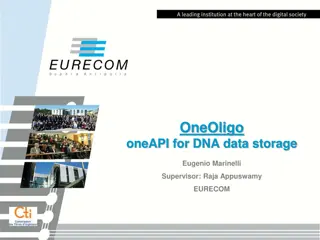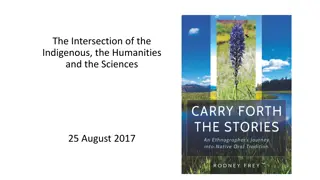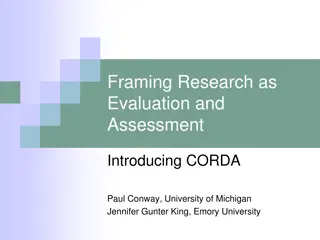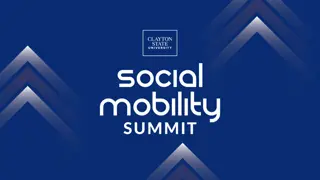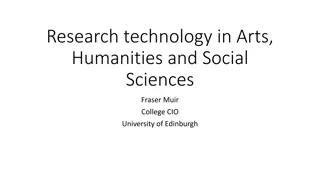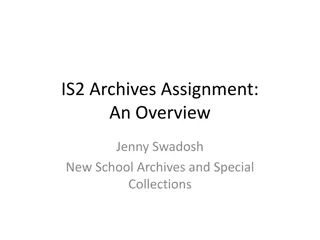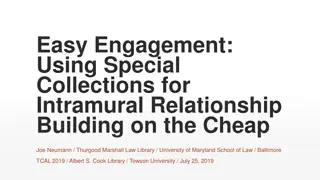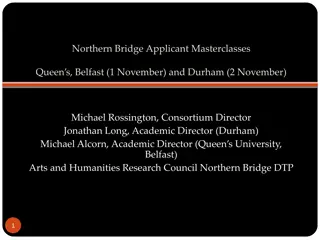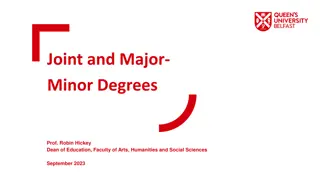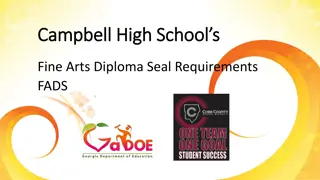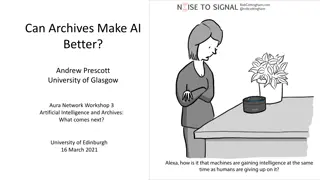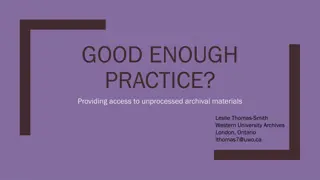Innovative Approach to Managing Archival Standards in Arts and Humanities
Explore the Standardization Survival Kit (SSK) and EHRI-EAD for a wider adoption of archival standards in Arts and Humanities. The SSK provides a documented and reusable system to manage the heterogeneity of EAD, offering an open platform for hosting resources related to metadata standards in research scenarios. Discover project-centered EAD customization and see how community standards like EAD and TEI play a crucial role in data integration, enrichment, and sharing lifecycles.
Download Presentation

Please find below an Image/Link to download the presentation.
The content on the website is provided AS IS for your information and personal use only. It may not be sold, licensed, or shared on other websites without obtaining consent from the author. Download presentation by click this link. If you encounter any issues during the download, it is possible that the publisher has removed the file from their server.
E N D
Presentation Transcript
The Standardization Survival Kit & EHRI- EAD For a wider use of archival standards within Arts and Humanities Charles Riondet (Inria Paris)
Outline Innovative way of managing heterogeneity of EAD; Documented and reusable, via the Standardization survival kit (SSK); Open platform for hosting resources related to metadata standards, curated in research scenarios.
The Standardization Survival Kit: a toolkit for Humanities scholars Documenting Supporting Training Communicating https://ssk.parthenos-project.eu/ssk/
The scenarios Providing contextual information and relevant examples on how standards can be applied in a given research project. Place your screenshot here
Three layers Us Scenario Step Resource A complete and generic A unique task to be performed A standardized tool / service / research use case composed of inside a scenario with the help document guiding the several steps to be followed. and recommendation of one or researcher in her/his tasks several resources. completion.
The TEI model The scenarios are described using the TEI format (Text Encoding Initiative). All the information displayed within the SSK proceed from TEI files. A scenario is a list of events (<tei:listEvent>), each step in a scenario is an event (<tei:event>). TEI files are all available on Github (https://github.com/ParthenosWP4/SSK).
Project-centered EAD customization A SSK scenario, derived from the EHRI use case Place your screenshot here with a focus on the role and the value of community standards, like EAD and TEI in data integration, enrichment, sharing lifecycles.
EHRI context and challenges Dispersed sources 1900 institutions with different: Histories of custody, Cataloguing practices, Digitization level A federated portal
EHRI & EAD Pivot format: EAD2002 + EHRI specific description rules When possible, automatic mapping from: EAD1, Dublin Core, home made formats EAD 2002 with very different encoding guidelines How to preserve content and meaning when exchanging/reusing archival content?
Proposal: EAD customizations Narrowing EAD countless possibilities Quality checks and content-oriented rules Without modifying the schema
How? TEI long lasting experience -> One document does it all (ODD): Schema fragments, prose documentation and reference documentation in a single document ODD allows for total flexibility to model specific subsets or extensions of the described format. Straightforward way to customize any XML format according to specific practices and document this customization
Defining an XML element with ODD <elementSpec ident="unittitle" module="EAD"> <gloss>Title of the Unit</gloss> <desc>The name, either formal or supplied, of the described materials. ...</desc> <classes> <memberOf key="att.EADGlobal"/> </classes> <content> <rng:zeroOrMore> <rng:choice> <rng:text/> <rng:ref name="unitdate"/> <rng:ref name="date"/> documentation <define name="unittitle"> </content> <exemplum> <element name="unittitle"> <a:documentation>(Title of the Unit) The name, either formal or supplied ...</a:documentation> <zeroOrMore> <choice> <text/> <ref name="unitdate"/> </exemplum> <remarks> <p>Do not confuse <gi>unittitle</gi> with Title <gi>title</gi>, ... </p>
ODD and EAD ... An ODD file that covers EAD entirely: The official schema: www.loc.gov/ead/ead.rng The Tag Library: http://loc.gov/ead Maintained by Parthenos (possibility to contribute and reuse) http://github.com/ParthenosWP4/standardsLibrary/blob/mas ter/archivalDescription/EAD/ODD/EADSpec.xml
and EHRI Very precise content oriented rules based both on EHRI and CHI input data models Integrating the human readable documentation in the validation process deepen the relationship between validation and documentation
Flexible and customizable methodology Use ODD to create specific EAD profiles Each new EAD profile => new ODD Inheritance to the master source + possibility to modify the elements that have a different behaviour Don t change the core EAD schema, but add more specific rules EAD schema (expressed in RelaxNG) ISO Schematron rules
Flexible and customizable methodology EAD Schema (RelaxNG, XML schema, DTD) EAD ODD generates EAD Tag library (HTML, PDF, eBook, ) inherits EHRI EAD Schema (RelaxNG+ schematron) EHRI EAD ODD generates EHRI EAD Tag Library
Creating EHRI EAD specification <schemaSpec ident="EHRI_EAD" start="ead" ns="urn:isbn:1-931666_22_9" source="https://raw.githubusercontent.com/ParthenosWP4/standardsLibrary/master/archivalDescription/EAD/odd/EADSpec.xml"> <elementSpec ident="altformavail" module="EAD" mode="change"> <constraintSpec ident="copyLinking" scheme="isoschematron" type="EHRI" mode="add"> <desc>If the element <gi>altformavail</gi> is not empty, you COULD try to identify if the originals are present in the EHRI portal and make a link between the two descriptions.</desc> <constraint> <rule xmlns="http://purl.oclc.org/dsdl/schematron" context="ead:altformavail" see="&path;#EAD.altformavail"> <assert xmlns="http://purl.oclc.org/dsdl/schematron" role="COULD" test="not(normalize-space(.))"> If the element altformavail is not empty, you COULD try to identify if the originals are present in the EHRI portal and make a link between the two descriptions</assert> </rule> </constraint> </constraintSpec> </elementSpec> Modify element Original EAD-ODD Add a constraint Schematron rule + message
Schematron rules Emphasize EAD validation errors Content normalisation (dates, codes, ) Align the descriptions with EHRI constraints e.g. require at least one <scopecontent> element Highlight some description elements that could be improved Not errors, but pieces of advice. In particular for content related elements (existence of copies of the material, bibliographical references, )
Connect to ad hoc documentation A full description of the expected content (i.e. HTML tag library ) is generated from the ODD file. In the validation process, the documentation is served to the user in context EAD technical documentation EHRI technical documentation EHRI qualitative documentation
EHRI validation Workflow (Re)process EAD validation EAD doc Input data in EAD (native or converted) EHRI-EAD schema EHRI validation schematron EHRI doc Validation results Re(process) + Comprehensive messages and guidelines
Reusable by nature Browse the SSK scenario https://ssk- application.parthenos.d4science.org/ssk/#/scenarios/AWIAi0m Re-S72mFoMfe-/1 (beta) Read the paper Laurent Romary, Charles Riondet, EAD-ODD: A solution for project-specific EAD schemes, Archival Science, 2018, https://hal.inria.fr/hal-01737568,
